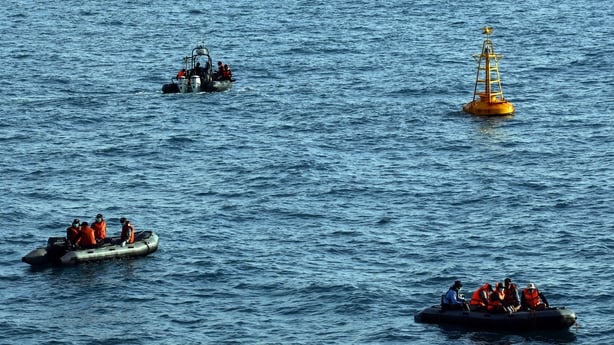Indonesian salvage teams have failed to raise the fuselage of AirAsia Flight 8501 from the sea bed, but recovered four more bodies from the wreckage of the crashed jet.
The bid to raise the fuselage came a day after divers were able to enter the main section of the plane for the first time.
The plane crashed in the Java Sea last month, killing all 162 people on board.
Difficult weather conditions for the past week had stopped rescuers reaching the main part of the Airbus A320-200 since it was spotted on the seabed by a military vessel earlier this month.
The operation to lift the main body will resume tomorrow.
Flight QZ8501 went down on 28 December in stormy weather, during what was supposed to be a short trip from the Indonesian city of Surabaya to Singapore.
Indonesian Transport Minister Ignasius Jonan said this week that the plane climbed abnormally fast before stalling and plunging into the sea.
Just moments before the plane disappeared off the radar, the pilot had asked to climb to avoid a major storm but was not immediately granted permission due to heavy air traffic.
"We were not successful today. The sling snapped off so the main body fell back to the sea floor," S B Supriyadi, a rescue agency official, said.
He added that several bodies fell from the fuselage when the piece of wreckage sunk once again.
The rescue agency official also said a sonar scan had detected an object "suspected to be the cockpit" of the plane about 500 metres away from the fuselage.
But the search teams will prioritise floating the main body before verifying the object suspected to be the cockpit, Supriyadi added.

Just after dawn today, divers began descending to the sea floor to tie floatation bags to the fuselage, said Rasyid Kacong, the navy official overseeing the lifting operation from on board the Banda Aceh warship.
Four bodies believed to have come from inside the fuselage were retrieved as the team tried to lift the main section, bringing the total number of bodies recovered to 69.
The previous day, a jumble of wires and seats floating inside the fuselage prevented the divers from entering further to find more bodies.
"The divers said it was dark inside, the seats were floating about and the wires were like a tangled yarn," Supriyadi said.
The rescuers hope that once the fuselage is lifted, it will be easier to inspect the inside of the main section, he added.
The jet's cockpit voice recorder and flight data recorder were recovered last week, and investigators are analysing them.

